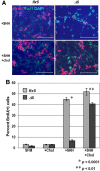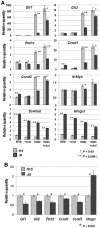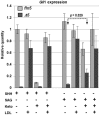Analysis of hedgehog signaling in cerebellar granule cell precursors in a conditional Nsdhl allele demonstrates an essential role for cholesterol in postnatal CNS development
- PMID: 25652406
- PMCID: PMC4406293
- DOI: 10.1093/hmg/ddv042
Analysis of hedgehog signaling in cerebellar granule cell precursors in a conditional Nsdhl allele demonstrates an essential role for cholesterol in postnatal CNS development
Abstract
NSDHL is a 3β-hydroxysterol dehydrogenase that is involved in the removal of two C-4 methyl groups in one of the later steps of cholesterol biosynthesis. Mutations in the gene encoding the enzyme are responsible for the X-linked, male lethal mouse mutations bare patches and striated, as well as most cases of human CHILD syndrome. Rare, hypomorphic NSDHL mutations are also associated with X-linked intellectual disability in males with CK syndrome. Since hemizygous male mice with Nsdhl mutations die by midgestation, we generated a conditional targeted Nsdhl mutation (Nsdhl(tm1.1Hrm)) to investigate the essential role of cholesterol in the early postnatal CNS. Ablation of Nsdhl in radial glia using GFAP-cre resulted in live-born, normal appearing affected male pups. However, the pups develop overt ataxia by postnatal day 8-10 and die shortly thereafter. Histological abnormalities include progressive loss of cortical and hippocampal neurons, as well as deficits in the proliferation and migration of cerebellar granule precursors and subsequent massive apoptosis of the cerebellar cortex. We replicated the granule cell precursor proliferation defect in vitro and demonstrate that it results from defective signaling by SHH. Furthermore, this defect is almost completely rescued by supplementation of the culture media with exogenous cholesterol, while methylsterol accumulation above the enzymatic block appears to be associated with increased cell death. These data support the absolute requirement for cholesterol synthesis in situ once the blood-brain-barrier forms and cholesterol transport to the fetus is abolished. They further emphasize the complex ramifications of cholesterogenic enzyme deficiency on cellular metabolism.
© The Author 2015. Published by Oxford University Press. All rights reserved. For Permissions, please email: journals.permissions@oup.com.
Figures









Similar articles
-
Developmental expression pattern of the cholesterogenic enzyme NSDHL and negative selection of NSDHL-deficient cells in the heterozygous Bpa(1H)/+ mouse.Mol Genet Metab. 2009 Dec;98(4):356-66. doi: 10.1016/j.ymgme.2009.06.016. Epub 2009 Jul 4. Mol Genet Metab. 2009. PMID: 19631568 Free PMC article.
-
Placental defects are associated with male lethality in bare patches and striated embryos deficient in the NAD(P)H Steroid Dehydrogenase-like (NSDHL) Enzyme.Mol Genet Metab. 2005 Jan;84(1):48-60. doi: 10.1016/j.ymgme.2004.08.007. Mol Genet Metab. 2005. PMID: 15639195
-
Analysis of Nsdhl-deficient embryos reveals a role for Hedgehog signaling in early placental development.Hum Mol Genet. 2006 Nov 15;15(22):3293-305. doi: 10.1093/hmg/ddl405. Epub 2006 Oct 6. Hum Mol Genet. 2006. PMID: 17028112
-
Mutations in the NSDHL gene, encoding a 3beta-hydroxysteroid dehydrogenase, cause CHILD syndrome.Am J Med Genet. 2000 Feb 14;90(4):339-46. Am J Med Genet. 2000. PMID: 10710235 Review.
-
Defects in cholesterol synthesis genes in mouse and in humans: lessons for drug development and safer treatments.Drug Metab Rev. 2011 Feb;43(1):69-90. doi: 10.3109/03602532.2010.540580. Drug Metab Rev. 2011. PMID: 21247357 Review.
Cited by
-
Cockayne Syndrome Patient iPSC-Derived Brain Organoids and Neurospheres Show Early Transcriptional Dysregulation of Biological Processes Associated with Brain Development and Metabolism.Cells. 2024 Mar 28;13(7):591. doi: 10.3390/cells13070591. Cells. 2024. PMID: 38607030 Free PMC article.
-
Multiple ligand binding sites regulate the Hedgehog signal transducer Smoothened in vertebrates.Curr Opin Cell Biol. 2018 Apr;51:81-88. doi: 10.1016/j.ceb.2017.10.004. Epub 2017 Dec 18. Curr Opin Cell Biol. 2018. PMID: 29268141 Free PMC article. Review.
-
Emerging Functional Connections Between Metabolism and Epigenetic Remodeling in Neural Differentiation.Mol Neurobiol. 2024 Sep;61(9):6688-6707. doi: 10.1007/s12035-024-04006-w. Epub 2024 Feb 10. Mol Neurobiol. 2024. PMID: 38340204 Free PMC article. Review.
-
Role of cholesterol and sphingolipids in brain development and neurological diseases.Lipids Health Dis. 2019 Jan 25;18(1):26. doi: 10.1186/s12944-019-0965-z. Lipids Health Dis. 2019. PMID: 30683111 Free PMC article. Review.
-
Statins Synergize with Hedgehog Pathway Inhibitors for Treatment of Medulloblastoma.Clin Cancer Res. 2018 Mar 15;24(6):1375-1388. doi: 10.1158/1078-0432.CCR-17-2923. Epub 2018 Feb 6. Clin Cancer Res. 2018. PMID: 29437795 Free PMC article.
References
-
- Saher G., Quintes S., Nave K.A. (2011) Cholesterol: a novel regulatory role in myelin formation. Neuroscientist, 17, 79–93. - PubMed
-
- Herman G.E. (2003) Disorders of cholesterol biosynthesis: prototypic metabolic malformation syndromes. Hum. Mol. Genet., 12 Spec No 1, R75–R88. - PubMed
-
- Mann R.K., Beachy P.A. (2004) Novel lipid modifications of secreted protein signals. Annu. Rev. Biochem., 73, 891–923. - PubMed
Publication types
MeSH terms
Substances
Grants and funding
LinkOut - more resources
Full Text Sources
Other Literature Sources
Medical
Molecular Biology Databases
Research Materials
Miscellaneous

